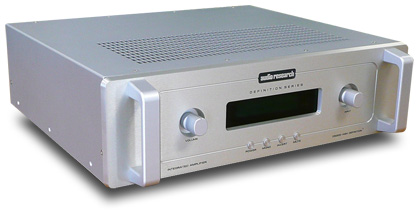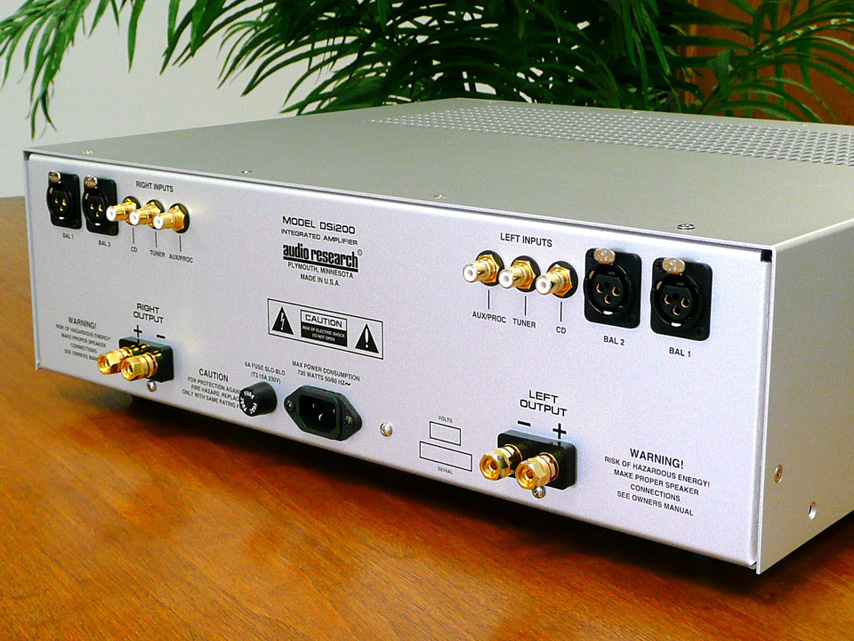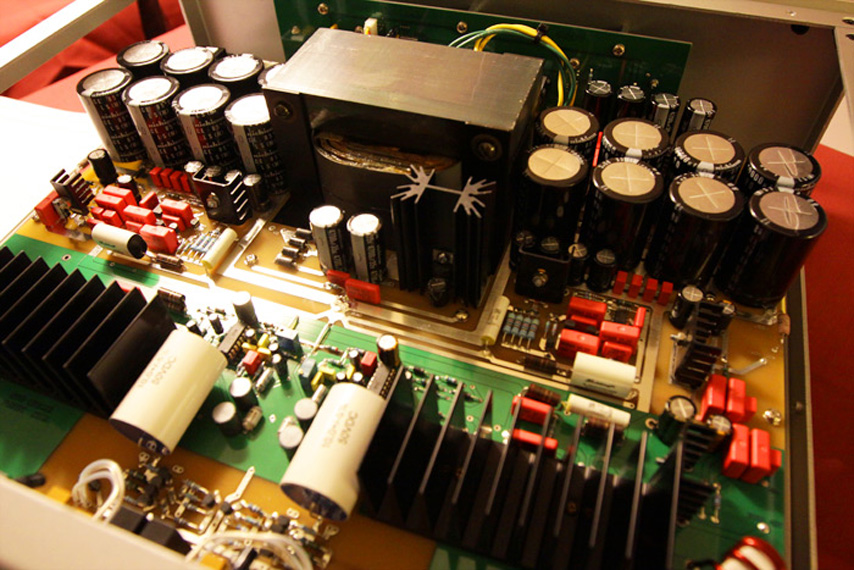 August 2010
Audio
Research DSi200 Integrated Amplifier
  There
was a time, in the not-too-distant past, when audiophiles believed
that top-shelf sound could be achieved only with separate components
-- that is, a separate preamp and power amp. They believed that the
humble integrated amplifier was too compromised a product to achieve
the top-quality sound desired by any self-respecting audiophile. And
class-D switching amps were only for subwoofers, or those who would
accept a compromised sound. There
was a time, in the not-too-distant past, when audiophiles believed
that top-shelf sound could be achieved only with separate components
-- that is, a separate preamp and power amp. They believed that the
humble integrated amplifier was too compromised a product to achieve
the top-quality sound desired by any self-respecting audiophile. And
class-D switching amps were only for subwoofers, or those who would
accept a compromised sound.
Since then, the
integrated amplifier has made the leap from convenient afterthought
to main showpiece -- and not only for the frugal or the
budget-constrained. Most makers of high-end electronics now wouldnít
be caught dead without an ambitious integrated in their product
line, for customers who want it all sonically while simplifying
their systems. Audio Research Corporation has a long and storied
history of making high-quality amplifiers, and beginning in 1997,
with the introduction of the CA50, also has made some pretty good
integrated amps. Now ARC has created its new Definition series,
which will run parallel to the Reference line but will concentrate
on emerging green technologies that can meet the excellent sonic
standard that has been a hallmark of ARC products through the years.
The class-D DSi200 is the first component in the new line -- as well
as being ARCís first all-solid-state integrated amplifier.
But does the DSi200
live up to its legendary heritage, or does it prove that audiophiles
were right all along: that separates are still the only way to reach
sonic nirvana?
Build quality
Audio Research calls the DSi200 ($5995 USD) a
fully balanced "hybrid solid-state" design. By "hybrid," ARC means
what they describe as a "massive, highly regulated, linear analog
power supply" combined with a "truly Ďgreení discrete analog
switching-MOSFET output stage for highly efficient power conversion
and low power consumption." This configuration helps the DSi200
consume few enough watts to earn it an Energy Star rating -- itís
claimed to burn only 38W at idle, so leaving it on 24/7 shouldnít be
a problem. While ARC claims that doing so will make the DSi200 ready
to sonically respond immediately, it requires about 30 minutes to
come up to speed from a cold start, and its sound will slightly
improve over the next hour or so. I found that the DSi200 sounded
good whether I had the power on 24/7 or not. The design of all
power-supply components and MOSFETs are by ARC; they donít come
prepackaged from some other, OEM firm. And while ARC tends to shy
away from calling the DSi200 a class-D amp, preferring instead the
phrase switching amplifier,
they admit that it is
class-D . . . but with their own unique take on the technology.
The DSi200ís
preamplifier stage is purely passive; there are no outputs for
connecting a separate power amp (or outboard headphone amp). The
DSi200 is rated to offer 200Wpc into 8 ohms or 300W into 4 ohms,
with dynamic outputs of 400Wpc into 8 ohms or a whopping 800W into 4
ohms. These power specifications are no doubt aided by the 160,000ĶF
of capacitance in the amply specified power supply. Output power is
of little concern; the DSi200 can drive even the most power-hungry
speakers.
As noted, the DSi200
is fully balanced. It has two balanced and three single-ended inputs
(one of which can be configured as a home-theater pass-through),
heavy-duty five-way binding posts, and an IEC socket for the
supplied power cord (or one of your choice) and the fuse holder.
Thatís all there is in back. A word of caution: When you hook up
your components and speakers, pay close attention to the jacks and
speaker binding posts. Likely because of the DSi200ís dual-mono
design, these connections are mirror-imaged; itís all too easy to
hook things up wrong, something I learned the hard way.

At 19"W x 5.25"H x
14.25"D and weighing 37.2 pounds, the DSi200 is a substantial piece
of gear with the classic Audio Research good looks, especially in
silver with rack handles -- and therein lies the biggest outward
difference. Instead of making the handles black, as has long been
ARCís wont, these are now the same color as the faceplate (the
DSi200 is also available in black). My review sample came in silver
with silver handles.
The display looks
very much like that of ARCís LS26 preamp. Out front, from left to
right, are the volume knob, a teal-green fluorescent display (it can
be dimmed or turned off completely), and the input selector knob.
Below the display are four buttons: Power, Mute, and two that you
seldom see these days but should: Mono and Invert (polarity, which I
found made a small but noticeable difference with certain discs).
All in all, a simple but effective, and visually appealing, design.
The slim, comfortable
remote control -- it looks like any other from ARC -- has all the
features found on the amp itself, with the welcome additions of
controls for balance and for dimming the display.

System
From front end to back, the components used for
this review were a
VPI
HW-19 Mk.IV
turntable, SME 309 tonearm, Lyra Argo phono
cartridge, Furutech AG-12 phono cable, Audio Research PH5 phono
stage, and Oppo DV-981HD
universal player.
Speakers were Paradigm Reference Studio
100 v.3s. Everything was hooked
up with
Analysis Plus Solo Crystal wire: Oval
interconnects and Oval 8
biwire speaker cables. All stock
power cords were replaced with Harmonic Technologies Pro AC-11s,
except for an Analysis Plus Power Oval 10 for the power amp.
Also used were
Salamander Archetype racks, Furutech deStat LP treatment,
Blue Circle
Audio
BC6000 power conditioner,
VPI
16.5 record-cleaning machine,
Hunt EDA
carbon-fiber record brush, Zerodust stylus cleaner, and lots of
accessories from Symposium Acoustics: Roller Blocks Series 2+,
Roller Block Jr.s, Fat Padz, Pod Points,
Ultra Platform,
Svelte Shelves,
and
Isis Shelf.
Sound
After Iíd given the
DSi200 some run-in time, the first thing that struck me was how
relaxed yet involving the sound was -- a rare combination. There was
an enticing subtlety to the sound of the DSi200. I found myself
being drawn into the music, hearing the ample spatial information,
subtle musical cues, and low-level information that makes music come
alive, as if itís the real thing. This made the DSi200 all the more
remarkable given its relatively reasonable price. There were
generous amounts of detail and air in the sound. That feeling of
being "right there" with the musicians emerged from one of the
quietest backgrounds itís been my privilege to hear -- when it
needed to be, the DSi200 was dead silent. Those black backgrounds
didnít obscure information, but allowed ambient cues to bloom as
naturally as they do live, which is what a good component should do.
Music played though
the DSi200 was never thrust in my face, nor was it ever subdued.
Yet, with the best recordings, there was more than enough definition
to create the illusion of live music. No matter what else I might
have been thinking of doing, its sound drew me in. Taking notes
while the DSi200 was playing was almost an exercise in futility.
Almost. The DSi200
was not one of those amplifiers that make great recordings sound
great and poor recordings sound horrible. It did better than that.
While it made the superb recordings in my library sound like the
demo material they are, it also made poor recordings -- usually the
music I like best -- sound better than I expected them to. No, it
didnít turn a sowís ear into a silk purse, but it did bring out the
best from whatever I fed it. That neat trick went a long way toward
making the time I spent with the DSi200 a real pleasure.
One of the DSi200ís
strong points was its reproduction of bass. Sure, this integrated
has plenty of power -- but Iíve heard many powerful amps that donít
have the DSi200ís combination of bass control and bass definition.
Each note in the bass line that helps open "Help Me Through the
Night," from Joe Walshís
So What
(LP, ABC Dunhill DSD-50171), was cleanly rendered, from the initial
transient through to the harmonic. Each strum had that purr that
marks a well-recorded electric bass guitar. Yet the bass never stood
out from the rest of the music -- it was just there, to be savored
if I wanted to pay particular attention to it, or enjoyed as an
equal part of the performance.
But no section of the audioband was pushed
ahead of the rest -- the ARC offered each a fair shake. This point
was brought home to me when I listened to a recording of Mozartís
Violin Concerto No.3, by violinist
Marianne Thorsen and the Trondheimsolistene (SACD, 2L38). The
orchestra was spread out from wall to wall, with good depth, and the
tone and timbre of each instrumental section was reproduced as
realistically as Iíve ever heard, with no one section dominating.
Thorsenís violin was all rosiny, the bow scraping over taut strings
and the sound transmitted by the wooden body. The word that leapt to
mind was lovely.
The DSi200 offered as
full a glimpse of the acoustic of the recording venue as the
engineer captured on tape. A new reissue of Thelonious Monkís
Something
in Blue (LP, Black Lion/Pure
Pleasure BLPP 30119) was a case in point. Monkís piano was front and
center, with Al McKibbonís bass set back to the left behind him and
Art Blakeyís drums set back to the right. Each musician had his own
space in which the sound of his instrument could bloom while
interacting with the sounds of the two other trio members. This was
something of a surprise -- my copy of the original Black Lion LP
doesnít sound anywhere near as good. Good classical recordings, too,
spread from wall to wall with an excellent sense of layered depth.
The tube-like richness of the DSi200ís sound
belied its solid-state origins. In Monkís solo on "Nice Work If You
Can Get It," also from Something in
Blue, each
note was full from start to finish, with a slight warmth that never
veered over the line into soft or flabby (or cold or sterile, for
that matter). The DSi200 fleshed out each note, making this LP sound
as close to live as Iíve ever heard it in my room. The DSi200 made
Monkís piano sound like a real, live percussion instrument in both
size and weight. The Definition series indeed!
Voices were
particular delights through the DSi200. Whether it was the deep,
masculine voice of someone like Steve Strauss or the angelic female
harmonies of the Wailiní Jennys, the DSi200 reproduced each singer
as a full-figured person standing right in front of me -- no
cardboard cutouts here. Dynamic range was another strong point: The
DSi200 could turn from quiet to loud on a dime, and its noise level
was so vanishingly low that those dynamic shifts jumped out from
that tomb-like silence the DSi200 did so well. For me, this went a
long way toward the suspension of my disbelief, and let me feel as
if I were in the presence of real musicians.
Unless you have bat ears, I doubt youíll be
disappointed with the DSi200ís highs, but they could sound subdued
with some recordings. In many ways, this was a good thing; it
ensured that the DSi200 never sounded harsh, bright, or edgy --
characteristics that I hate because they compromise the music and,
to my ears, scream "Itís canned!"
The DSi200 never gave that impression. When I listened to "Bloody
Well Right," from Supertrampís
Crime of
the Century (LP, A&M SP-3647), while
the Fender Rhodes electric piano that opens the track didnít have
quite the metallic ring that Iíve heard through other amps, it still
sounded realistic. Nor did well-recorded cymbals shimmer quite as
brightly as Iíve heard them through some other combinations of
electronics. I think ARC has voiced the DSi200 just right, but you
should hear it for yourself.
Comparison
I pitted the DSi200 against my combination of
Audio Research LS17 preamp and Bryston 4B-SST≤ power amp. The DSi200
was a revelation in some areas. Both separates and integrated
offered a full, rich, fairly evenly balanced sound. While the
ARC-Bryston combo went deeper in the bass and with more control, it
was not a night-and-day difference. The ARC-Bryston combo also had a
cleaner, sweeter, more open top end, though again, it was not a huge
advantage. But the DSi200 countered with a top-to-bottom
cohesiveness, a midrange richness, and a definition to the music
that the ARC-Bryston couldnít quite match. While the separates could
lean
a
tad toward the dark side, the DSi200
offered a more even tonal presentation.
The DSi200 integrated
can stand among the best separate components out there and not have
to hang its head for anything -- including its price. Together, my
separates cost $2195 more than the DSi200, even without factoring in
the additional cost of a pair of high-quality interconnects, which
the DSi200 renders unnecessary.
Conclusion
The Audio Research
DSi200 not only caught my attention when I first listened to it, but
rewarded further listening by continuing to demonstrate its sonic
abilities with more and more depth -- during the review period, I
found myself looking for ways to free up more time to listen to my
favorite music. The more I listened, the more I came to appreciate
the overall qualities of this top-notch integrated amplifier.
If
youíre among those whose noses are bent out of joint at the mere
thought that an integrated amplifier -- and a solid-state class-D
amp at that -- might be able to offer all the sonic goods delivered
by the best separates, then you need to give a close listen to the
DSi200. I donít care what youíre looking for, whether youíre on a
budget, looking to downsize, upgrade, or whatever: You need to hear
this integrated. But get ready to have your preconceptions about
solid-state and class-D amps take a beating: The DSi200 can stand
with the best separates Iíve heard.
. . . John Crossett
johnc@soundstagenetwork.com
|
Audio Research DSi200 Integrated
Amplifier
Price: $5995 USD.
Warranty: Three years
parts and labor.
Audio Research Corp.
3900 Annapolis Lane North
Plymouth,
MN
55447-5447
Phone: (763) 577-9700
Fax: (763) 577-0323
Website:
www.audioresearch.com
|
|

